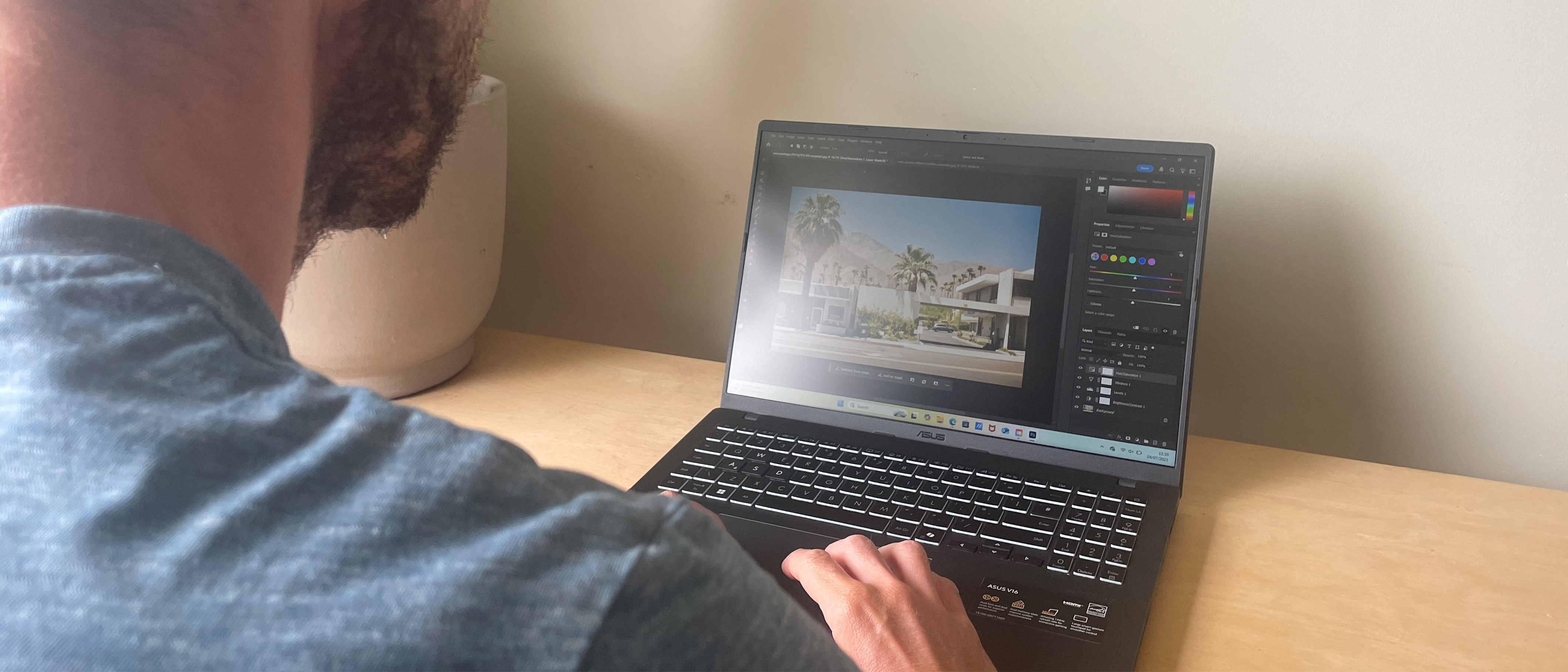Our Verdict
The ASUS V16 delivers reasonable GPU performance but is let down by its partner in crime, the underpowered Intel Core 5 CPU. It's a laptop that will perform admirably when carrying out light creative tasks and will work well for graphic designers, but if you try and push it harder, then it starts to struggle.
For
- Great GPU performance
- Quick refresh rate
- Reasonable battery life
- Sleek machine
Against
- Only an LCD display
- Lacks CPU power for demanding creative tasks
- Too much flexibility in the screen
Why you can trust Creative Bloq
The ASUS V16 is a portable laptop that is designed for both gamers and creators who need a balance of performance and affordability. It boasts an impressive NVIDIA GeForce RTX 4050, which is renowned for its graphics performance. Unfortunately, ASUS, in pursuit of keeping the price down, has paired it with a Core 5 processor rather than a more capable i7 or i9 alternative.
When I saw this mix of hardware, I immediately expected the laptop to struggle, especially when it came to higher-end creative tasks such as video editing and rendering. We've performed a wide range of benchmarks, and we recommend reading on to find out whether this laptop will feature in our guides to the best laptops for graphic design or video editing.
I've been using the machine for a few weeks and have worked on a range of creative projects, browsed the web, watched videos, and put the keyboard through its paces with some word processing.
Key specifications
CPU: | Intel Core 5 210H |
Graphics: | NVIDIA GeForce RTX 4050 |
Memory: | 16 GB, DDR5 |
Storage: | 512 GB SSD |
Screen size: | 16-inch |
Screen type: | LCD |
Resolution: | 1920 x 1200 |
Refresh rate: | 144Hz |
Colour gamut: | Not specified |
Brightness: | 300 nits |
Ports: | HDMI 2.1 x1, USB-C x1, USB-A x2, Audio jack |
Wireless connectivity: | Wi-Fi 6, Bluetooth |
Dimensions: | 35.70 x 25.07 x 1.80 x 2.20 cm |
Weight: | 1.95 kg (4.29 lbs) |
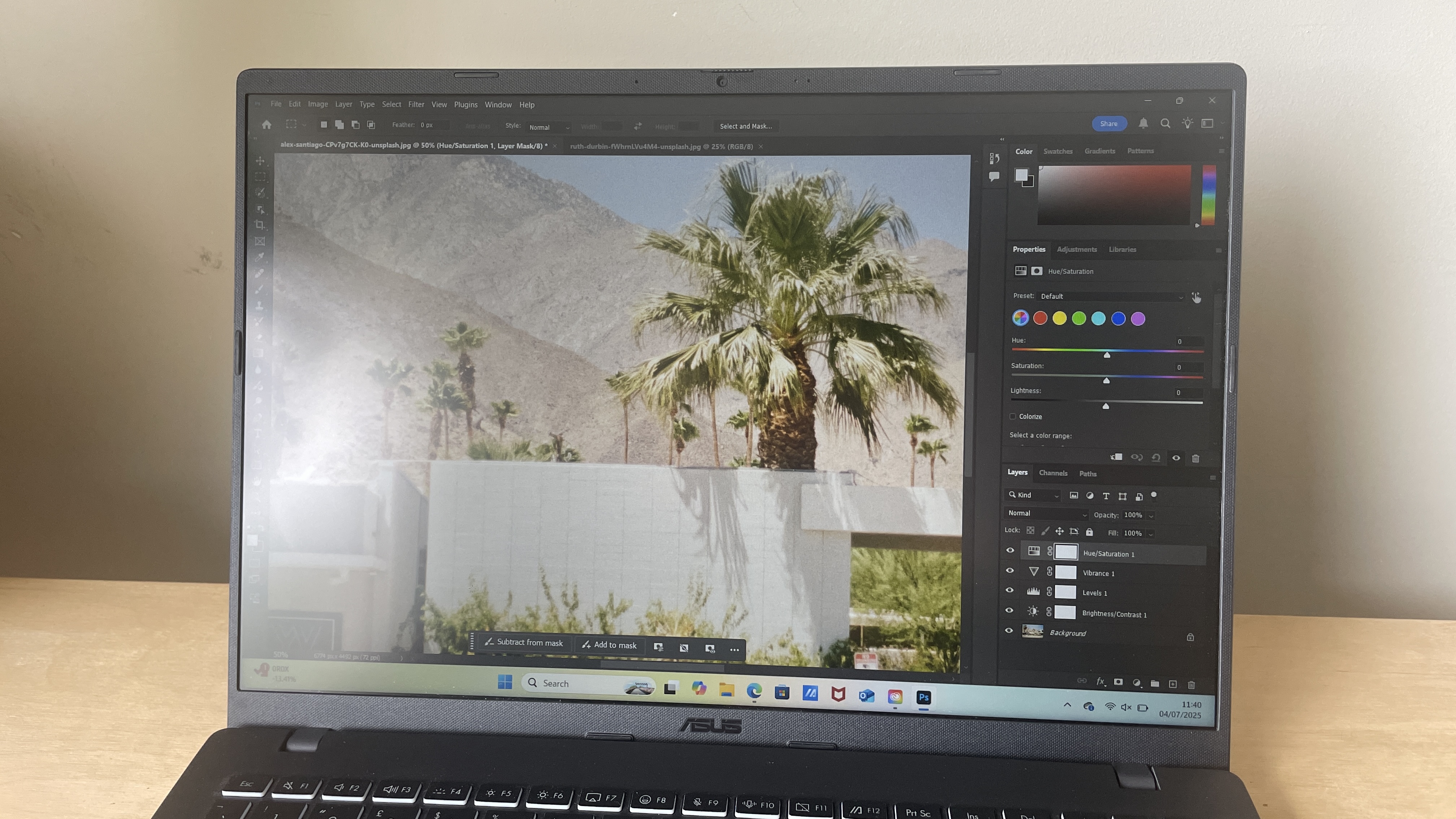
Design, build and display
• Sleek and lightweight design
• Gorgeous matte dark grey finish
Not everyone wants to be carting a 16-inch laptop around, but when it's as light and thin as the ASUS V16, you won't begrudge it too much. It also has the benefit of having a large enough display to not always require a second monitor. This is often the distinct disadvantage of 13 and 14-inch laptops. As a result, students and remote workers will love being able to work anywhere they want.
The overall design is fairly simple, but because of its matte grey finish, it looks pretty sleek. The downside of the matte covering is that it's terrible for leaving fingerprints. I dusted and cleaned the case for these review photos, but I wouldn't be surprised if some prints still made it into the shots.
The laptop adheres to MIL-STD 810H military standards, which ensures a robust build quality. I can understand this achievement when inspecting the base, but unfortunately, the display suffers from quite a lot of flex. You'll need to make sure you open and close the lid with two hands and are gentle with it.
Daily design news, reviews, how-tos and more, as picked by the editors.
Despite being too flexible, the display actually delivers quite a nice image. Its colour accuracy and viewing angles would definitely be its strengths, although it's not too bad for contrast either. It is an IPS display, so none of this will come as a surprise.
The keyboard is full-size with a numpad off to the right. This means that the touchpad is offset to the left, which, if you've read any of my laptop reviews, you will know is a personal bugbear of mine. Other than having to position myself off to the left slightly, the experience of typing is actually not too bad. The keys are easy to depress, and a travel of 1.7mm makes for a pleasant level of spacing.
The laptop is relatively limited in terms of ports with HDMI 2.1 x1, USB-C x1, USB-A x2, and an audio combo jack. The lack of an Ethernet port might dissuade some gaming enthusiasts, and the presence of only one USB-C port is a little disappointing. The laptop also has dual-driver speakers and a 1080p webcam with a privacy shutter.
Design score: 4/5
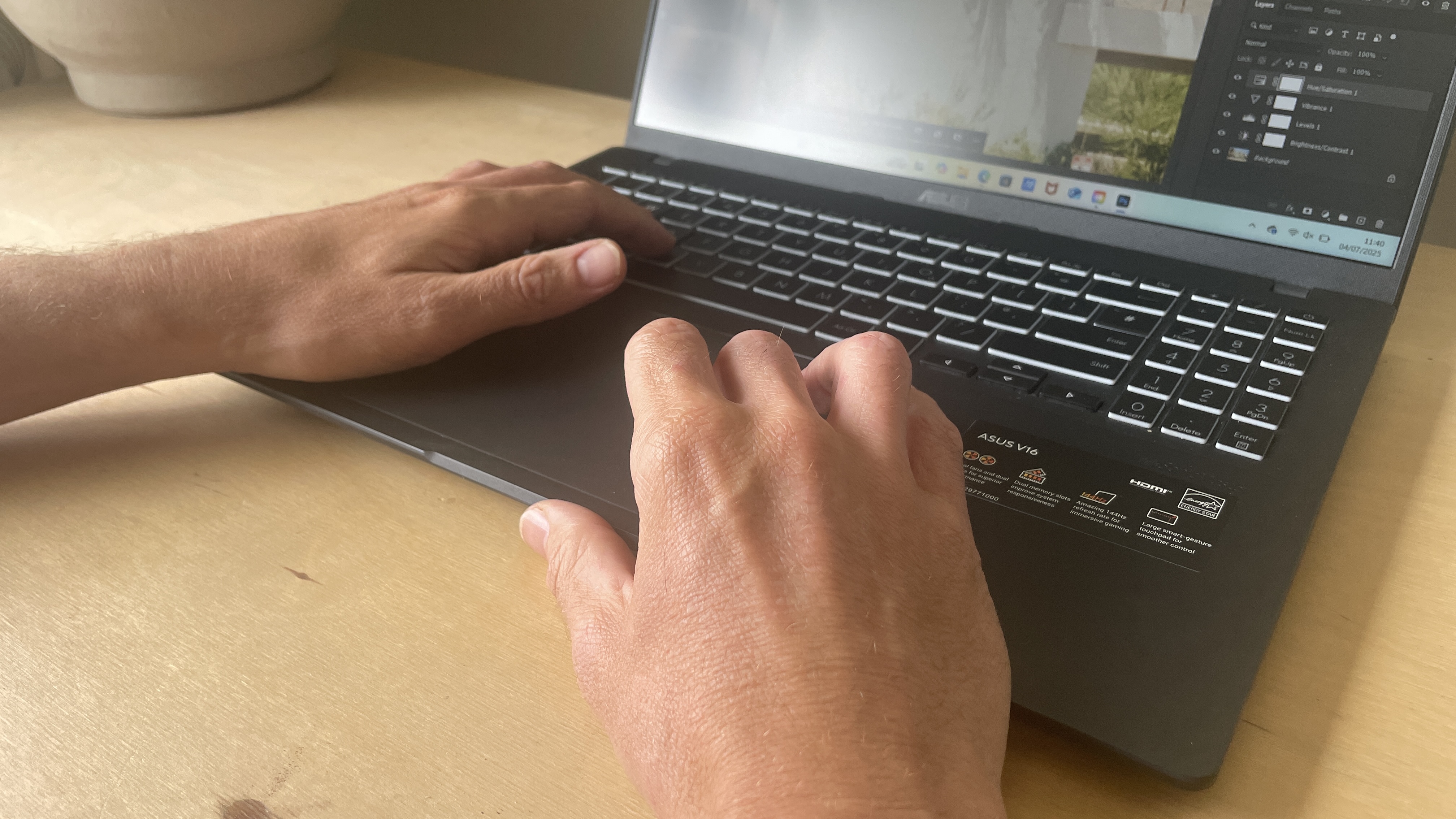
Features
• Reasonable GPU but let down by the CPU
• High-performing IceCool cooling system
In terms of hardware, there's an Intel Core 5 processor and an NVIDIA GeForce RTX 4050 laptop GPU. Alongside this, there's a 512GB SSD and 16GB of RAM (DDR5). There's nothing to write home about here, and if anything, the Core 5 CPU sticks out as inferior compared to the rest.
The machine can be upgraded to an Intel Core 7 processor, but this wasn't the one I was sent to test. The superior CPU would no doubt partner the 4050 laptop GPU better, but without experiencing it, I can't really comment.
The GeForce RTX 4050 GPU has DLSS 3.0, which delivers excellent performance. It also boasts real-time ray tracing, which lends itself to rendering game images efficiently. The GPU is also AI-augmented for computing process optimisation, although the lack of an AI branding focus on this laptop is rather refreshing.
The 16-inch display has a 1920 x 1200 resolution and a refresh rate of 144 Hz. This results in super smooth gameplay and is ideal for creatives working in animation. The 16:10 aspect ratio is ideal when working on portrait images or long documents.
The laptop features an advanced IceCool cooling system with dual fans and heat pipes. This efficient system is ideal for gaming and when the going gets tough. When I put it through its paces, I didn't hear the fans at all, so they're clearly up to the task.
Feature score: 4/5
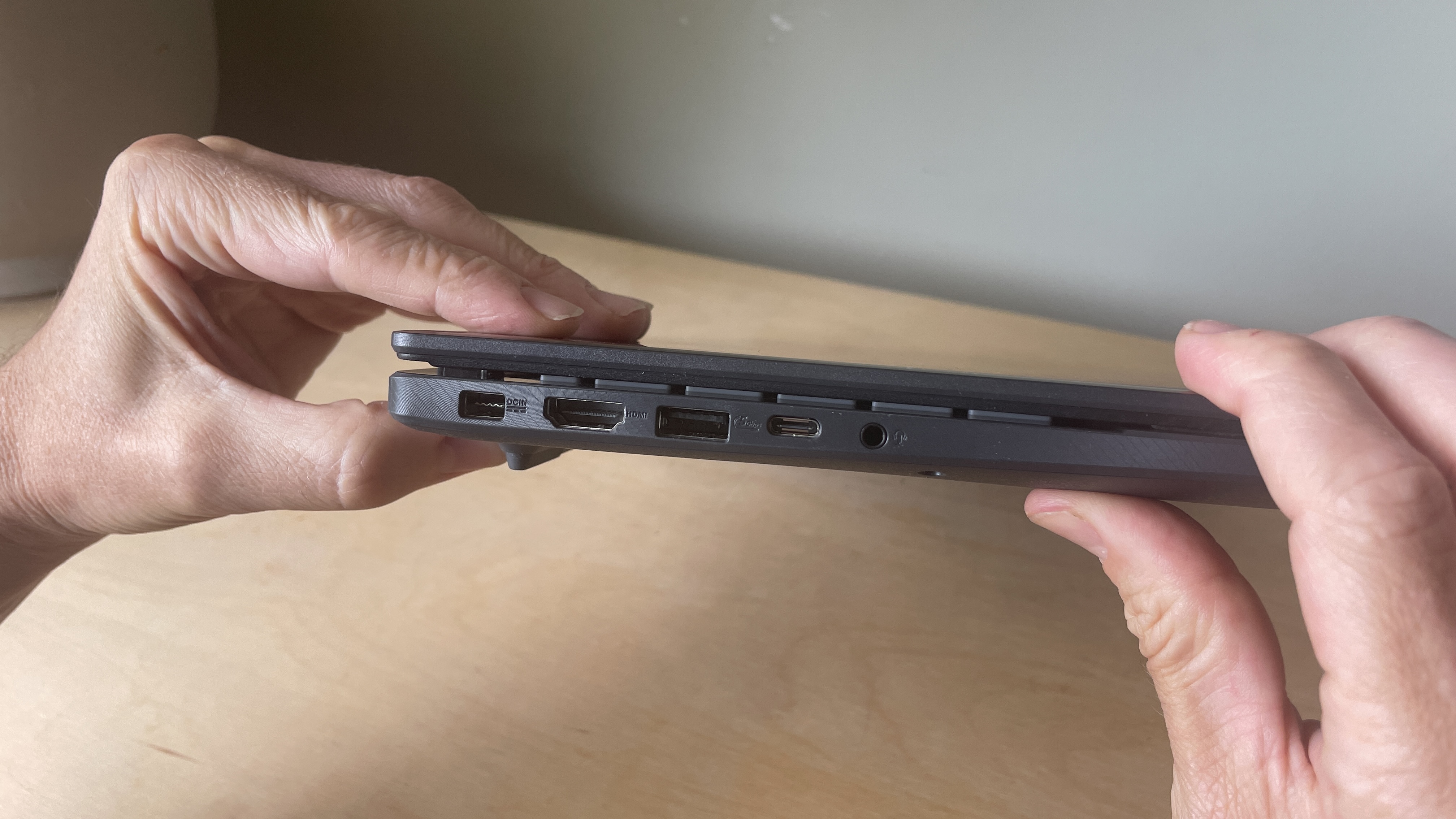
Benchmark scores
We test every one of our laptops using the same benchmarking software suite to give you a thorough overview of its suitability for creatives of all disciplines and levels. This includes:
• Geekbench: Tests the CPU for single-core and multi-core power, and the GPU for the system's potential for gaming, image processing, or video editing. Geekbench AI tests the CPU and GPU on a variety of AI-powered and AI-boosted tasks.
• Cinebench: Tests the CPU and GPU's ability to run 3D software such as Cinema 4D and Redshift.
• UL Procyon: Uses UL Solutions' Procyon software suite to test the system's ability for AI image generation in Stable Diffusion, its Microsoft Office performance and its battery life in a looping video test.
• Topaz Video AI: We use Topaz Video AI to test the system's ability to upscale video and convert video to slow-motion.
• PugetBench for Creators: We use the PugetBench for Creators benchmarking suite to test the system's ability to run several key tasks in Photoshop and Adobe Premiere Pro, as well as its performance when encoding/transcoding video.
• ON1 Resize AI: Tests the system's ability to resize 5 photos to 200% in a batch process. We take the total time taken to resize the images and divide by 5.
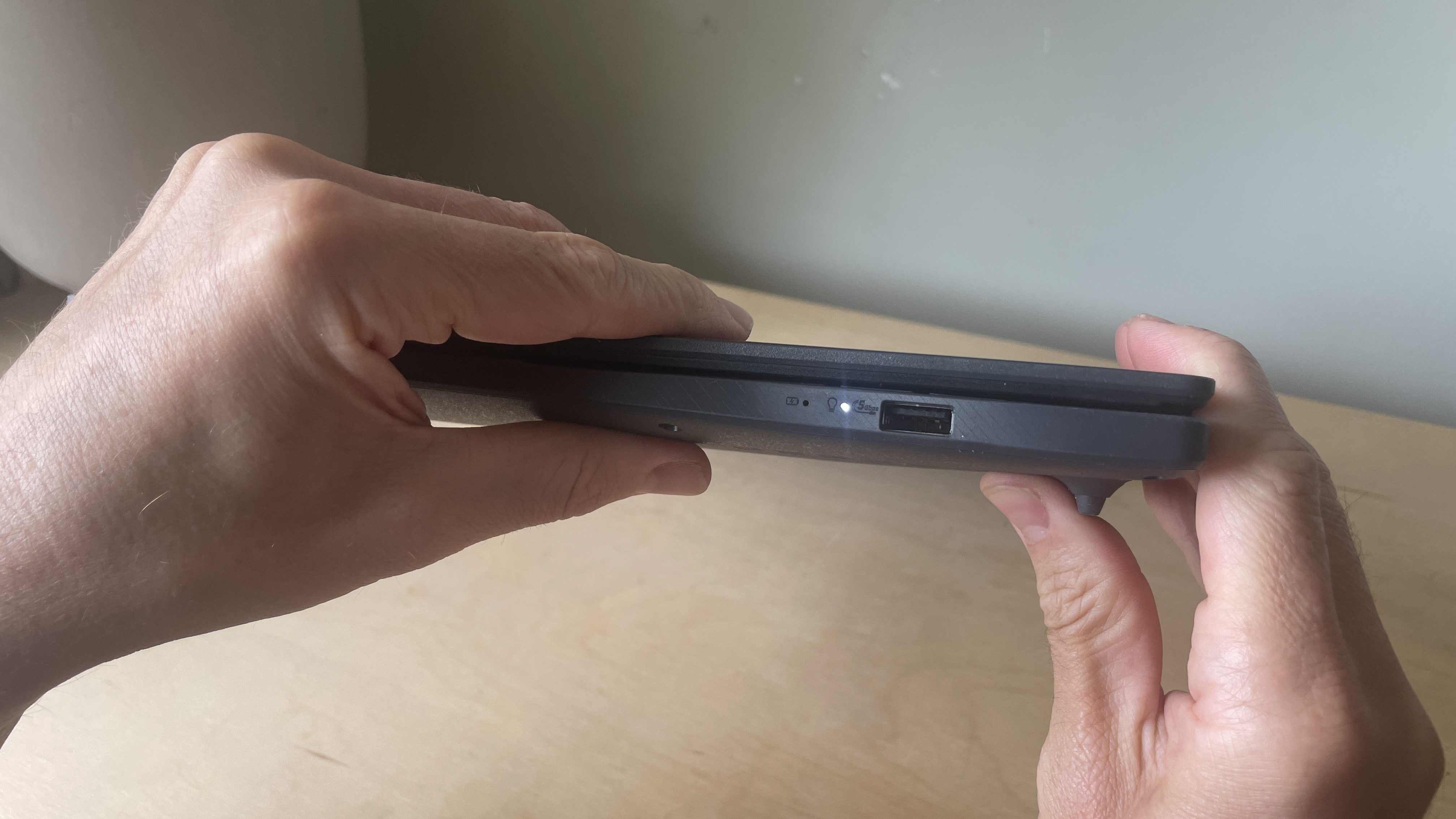
Performance
• Mid-range CPU and GPU performance
• A whole day's battery life, but don't push it too hard
Right, let's get to the heart of it with regards to performance.
In terms of CPU, our Geekbench scores show the ASUS V16 sitting very close to the Acer Swift 3 and HP Elitebook X G1i. These tests confirmed my fears that the Intel Core 5 processor really does restrict this laptop to students and creatives who demand very little from their creative endeavours.
I had hoped for a certain level of redemption with Cinebench benchmarking scores, but those were equally underwhelming, unfortunately. If you're looking for a machine for 3D visualisation and rendering, then you'll want something like the Acer Predator Helios 18 instead.
Pugetbench tests show reasonable performance in Photoshop but subpar results in Premiere Pro. This is no surprise given the extra hardware resources required for video editing. Again, if you're working in graphic design or occasional photo editing, then you'll be fine, but push it harder and things will start to creak.
This is far from a dedicated AI laptop, but with an NVIDIA GeForce RTX 4050 GPU, I was expecting reasonable performance across our UL Procyon, Topaz Video AI and ON1 Resize tests. Despite mid-range performance for image resizing, it came almost bottom of our image-generation tests in Procyon. None of this is a surprise, given these AI smarts will be most demonstrated and felt when gaming.
The 8 hours of battery life puts it very close to the performance of the Dell 16 Plus 2-in-1. This test was a video playback test, though, so if you're hoping to get the same battery performance when working on creative projects or while gaming, then you'll have to think again. If you're working remotely and need a whole day's juice, then make sure you take your charger.
All of these benchmarking results could make you think that this is a poor laptop, but I think it's better to know what you're buying. This is an affordable laptop that has a distinct focus on gaming. Hardware specs are tailored towards that pass time with corners being cut elsewhere. If you're into gaming or are looking for a reasonable laptop for a range of tasks then the ASUS V16 will serve you well.
Performance score: 3.5/5
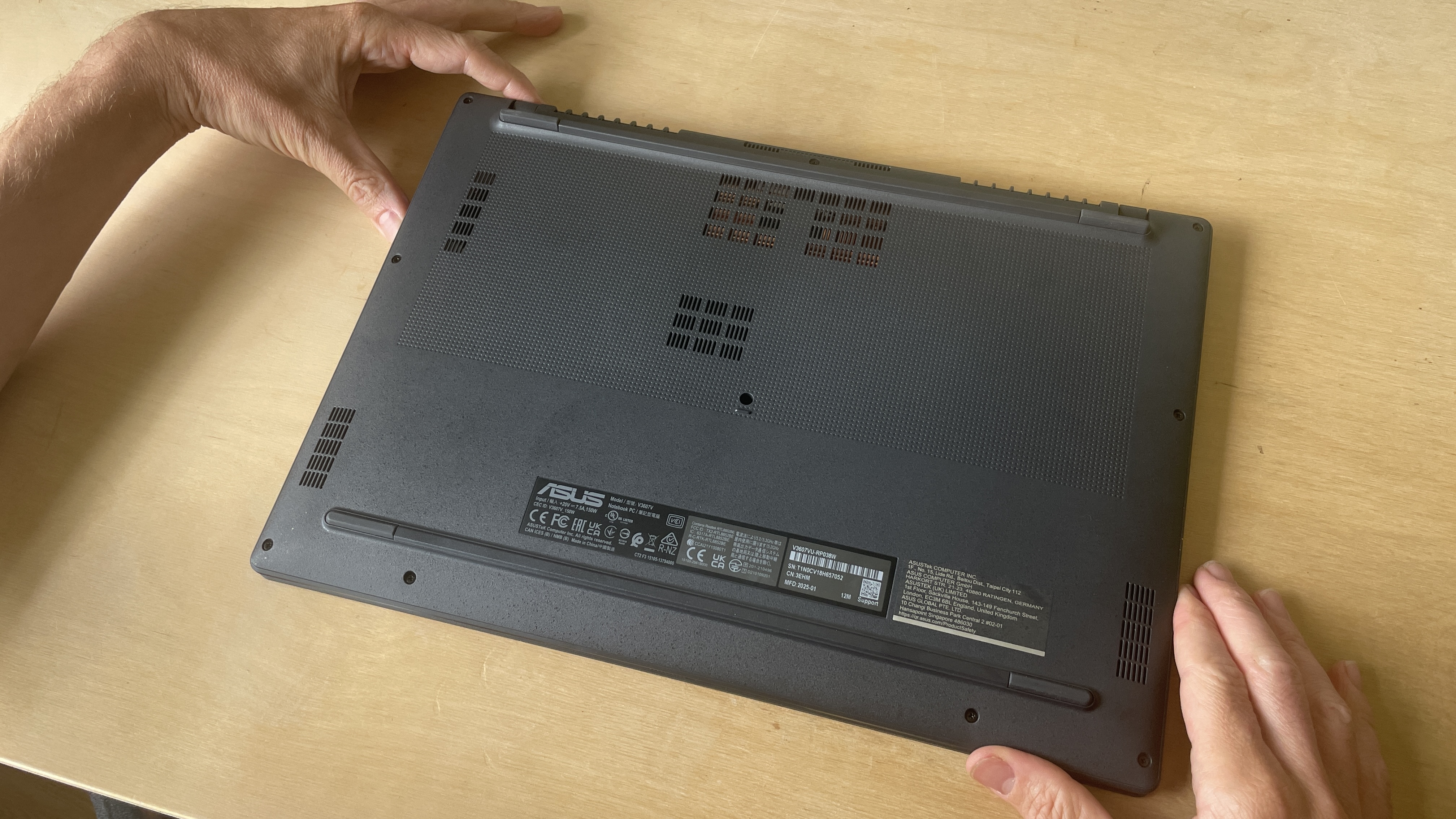
Price
The ASUS V16 costs £799/$949, which puts it at the more affordable end as far as laptops that are designed for gamers and creatives go. Despite being more expensive than the super-budget laptops that cost only a few hundred pounds/dollars, you are getting an excellent GPU that cuts the mustard for gaming. If you're looking for a machine to suit creatives rather than gamers, then I'd pay a little bit more and go for the MacBook Air 15-inch instead.
Value score: 4.5/5
Who is it for?
• Primarily for gamers but will suit some creatives
The ASUS V16 is designed primarily for gamers, although creatives who don't demand too much from their creative applications will find a friend in this laptop. A 144 Hz refresh rate and NVIDIA GeForce RTX 4050 GPU demonstrate this laptop's gaming acumen. General users who do a little bit of Photoshop work or anyone who spends most of their time on the web or working on documents will be absolutely fine.
Attributes | Notes | Rating |
|---|---|---|
Design: | A sleek design with a good-looking matte grey finish. | 4/5 |
Features: | A fairly standard set of specs which are boosted by the NVIDIA GeForce RTX 4050 GPU. | 4/5 |
Performance: | Mid-range CPU and GPU performance but definitely lacking for AI tasks. | 3.5/5 |
Value: | A reasonably priced laptop given the specs. | 4.5/5 |
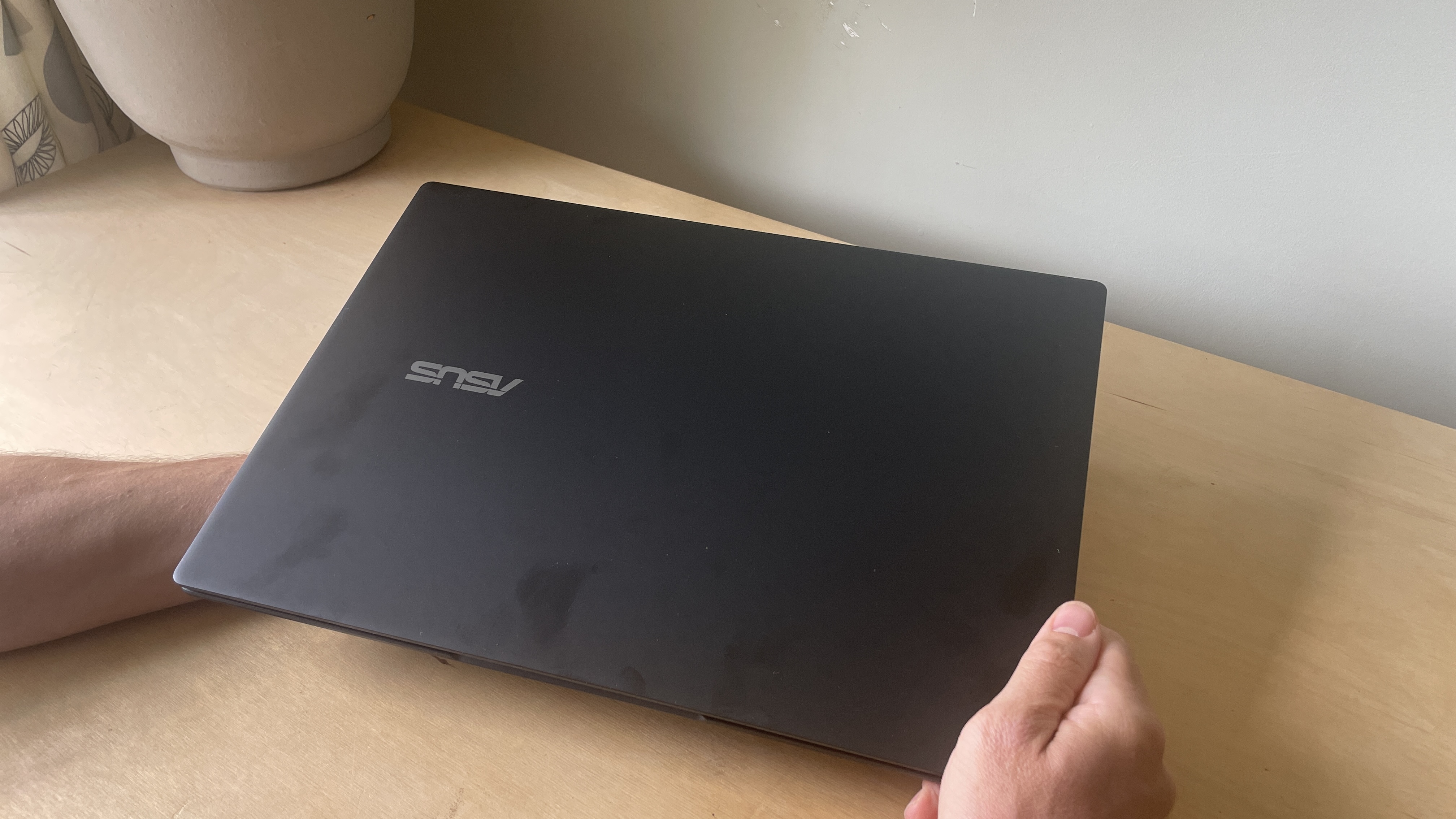
Buy it if...
- You need a laptop that suits gamers and creatives
- You want an affordable laptop with reasonable specs
- You need a portable laptop with a large display
Don't buy it if...
- You're a 3D visualiser or video editor
- You're involved in AI image generation
- You'll be pushing creativity to the limit
Also consider
A lightweight laptop for creatives who only work on minimally demanding projects. It's a winner when it comes to portability but can't be relied upon if the going gets tough.
An ultra-thin and light laptop that boasts an incredibly high-performing processor. If you're open to an Apple laptop over and above a Windows one, then the MacBook Air should definitely be in your shortlist.
out of 10
The ASUS V16 delivers reasonable GPU performance but is let down by its partner in crime, the underpowered Intel Core 5 CPU. It's a laptop that will perform admirably when carrying out light creative tasks and will work well for graphic designers, but if you try and push it harder, then it starts to struggle.

Paul is a digital expert. In the 20 years since he graduated with a first-class honours degree in Computer Science, Paul has been actively involved in a variety of different tech and creative industries that make him the go-to guy for reviews, opinion pieces, and featured articles. With a particular love of all things visual, including photography, videography, and 3D visualisation Paul is never far from a camera or other piece of tech that gets his creative juices going. You'll also find his writing in other places, including Creative Bloq, Digital Camera World, and 3D World Magazine.
You must confirm your public display name before commenting
Please logout and then login again, you will then be prompted to enter your display name.
